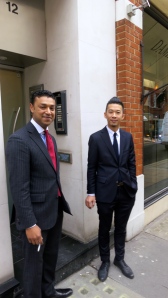 Against the odds, Jackie got me to Southampton Parkway in the nick of time for the London train for my visits to Norman and Carol.
Against the odds, Jackie got me to Southampton Parkway in the nick of time for the London train for my visits to Norman and Carol.
Today being Red Nose Day, the culmination of national efforts to raise money for children’s charities, Red Noses gathered on Waterloo station concourse, from where I walked to Bond Street station and boarded the Jubilee Line train to Neasden.
 As usual photographers were shooting their companions against the backdrop of London monuments.
As usual photographers were shooting their companions against the backdrop of London monuments.  When a young oriental gentleman saw what I was doing, he insisted on returning the favour.
When a young oriental gentleman saw what I was doing, he insisted on returning the favour.  At least, that is what I thought he was saying. But then language wasn’t really a problem. His intentions were clear.
At least, that is what I thought he was saying. But then language wasn’t really a problem. His intentions were clear.
This time I took the direct route from Piccadilly, up Old, then New Bond Streets.  The class of the shops and the expense of their goods reduces somewhat once you have passed the flower stall alongside Churchill and Roosevelt still amusing each other at the graft linking Old and New.
The class of the shops and the expense of their goods reduces somewhat once you have passed the flower stall alongside Churchill and Roosevelt still amusing each other at the graft linking Old and New.

 Forests of flags festooning their upper facades proclaim the outlets, and the retailers’ displays, both inside and out, are as colourfully artistic as ever.
Forests of flags festooning their upper facades proclaim the outlets, and the retailers’ displays, both inside and out, are as colourfully artistic as ever.
Huge, stony-faced doormen stand guard before the exclusive jewellers; a less scary uniformed attendant stands at the entrance to Burlington Arcade; and, as elsewhere in London, staff stand outside their workplaces smoking cigarettes.  Two young men were most amused to be thought of as an integral part of the capital’s modern scene. The metropolis has, for different reasons, borne the nickname ‘The Smoke’, since at least Victorian times. This is because of the number of coal fires that were lit throughout the city during that era. The great smog of 1952 described on 6th January was instrumental in having a stop put to this.
Two young men were most amused to be thought of as an integral part of the capital’s modern scene. The metropolis has, for different reasons, borne the nickname ‘The Smoke’, since at least Victorian times. This is because of the number of coal fires that were lit throughout the city during that era. The great smog of 1952 described on 6th January was instrumental in having a stop put to this.
The contrast between this most opulent thoroughfare and Church Road, NW10 could not be more marked.
Norman served up tuna steaks, pilau rice, and roasted vegetables, followed by raspberry trifle, complemented by an excellent Pinot Noir. Thus replenished I returned to the tube for a trip to Carol’s in SW1.
At Neasden I met and spoke with a peaceful Egyptian Muslim. His view was that religion should not be mixed with politics. No faith required us to kill people. Although he was too young to have known him, he spoke fondly of Anwar Sadat, whose assassination I had seen reported on French television in 1981. He told me that those behind the death of the former president were now in power and a revolution was being mounted to oust Mohamed Morsi, who would not leave voluntarily. More bloodshed was inevitable. Arab Spring had brought this about.
It had rained on and off all day in London, and when Jackie collected me at Southampton it was pouring there too.

the same red phone box:))
Indeed. I didn’t tell you in my comment on yours because I wanted to surprise you :). Thanks very much